TOYOTA SEQUOIA 2022 Owners Manual
Manufacturer: TOYOTA, Model Year: 2022, Model line: SEQUOIA, Model: TOYOTA SEQUOIA 2022Pages: 592, PDF Size: 10.82 MB
Page 421 of 592
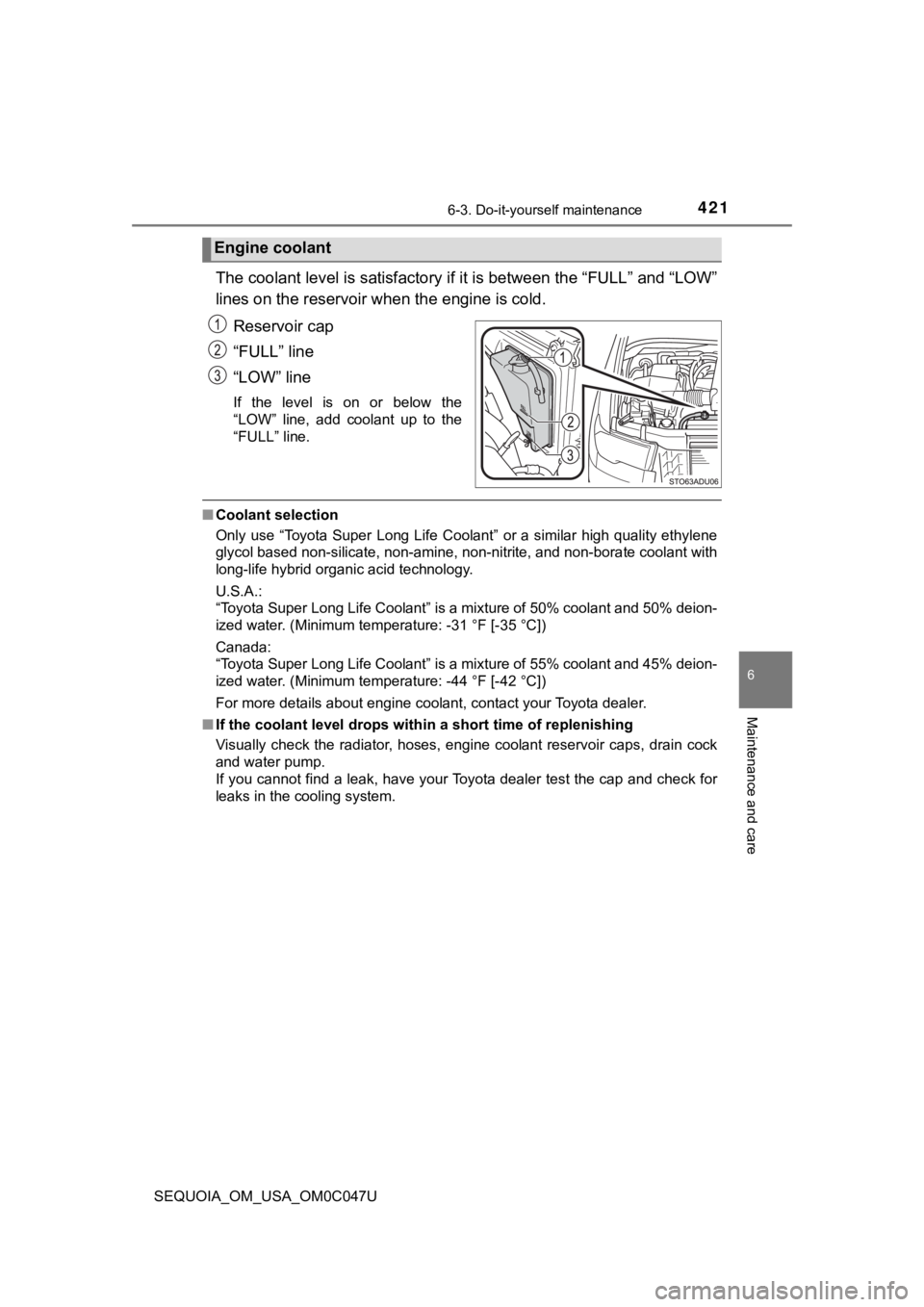
4216-3. Do-it-yourself maintenance
6
Maintenance and care
SEQUOIA_OM_USA_OM0C047U
The coolant level is satisfactory if it is between the “FULL” a nd “LOW”
lines on the reservoir wh en the engine is cold.
Reservoir cap
“FULL” line
“LOW” line
If the level is on or below the
“LOW” line, add coolant up to the
“FULL” line.
‚ñÝ Coolant selection
Only use “Toyota Super Long Life Coolant” or a similar high quality ethylene
glycol based non-silicate, non-amine, non-nitrite, and non-bora te coolant with
long-life hybrid organic acid technology.
U.S.A.:
“Toyota Super Long Life Coolant” is a mixture of 50% coolant and 50% deion-
ized water. (Minimum temperature: -31 °F [-35 °C])
Canada:
“Toyota Super Long Life Coolant” is a mixture of 55% coolant and 45% deion-
ized water. (Minimum temperature: -44 °F [-42 °C])
For more details about engine coolant, contact your Toyota deal er.
‚ñÝ If the coolant level drops within a short time of replenishing
Visually check the radiator, hoses, engine coolant reservoir ca ps, drain cock
and water pump.
If you cannot find a leak, have your Toyota dealer test the cap and check for
leaks in the cooling system.
Engine coolant
Page 422 of 592

4226-3. Do-it-yourself maintenance
SEQUOIA_OM_USA_OM0C047U
Check the radiator and condenser and clear away any foreign objects.
If either of the above parts is extremely dirty or you are not sure of
their condition, have your vehicle inspected by your Toyota dea l e r.
WARNING
‚ñÝWhen the engine is hot
Do not remove the engine coolant reservoir cap or the radiator cap.
(ÔÇÆP. 516)
The cooling system may be under pressure and may spray hot coolant if the
cap is removed, causing serious injuries, such as burns.
NOTICE
‚ñÝ When adding coolant
Coolant is neither plain water nor straight antifreeze. The cor rect mixture of
water and antifreeze must be used to provide proper lubrication, corrosion
protection and cooling. Be sure to read the antifreeze or coolant label.
‚ñÝ If you spill coolant
Be sure to wash it off with water to prevent it from damaging p arts or paint.
Radiator and condenser
WARNING
‚ñÝWhen the engine is hot
Do not touch the radiator or condenser as they may be hot and c ause seri-
ous injuries, such as burns.
Page 423 of 592
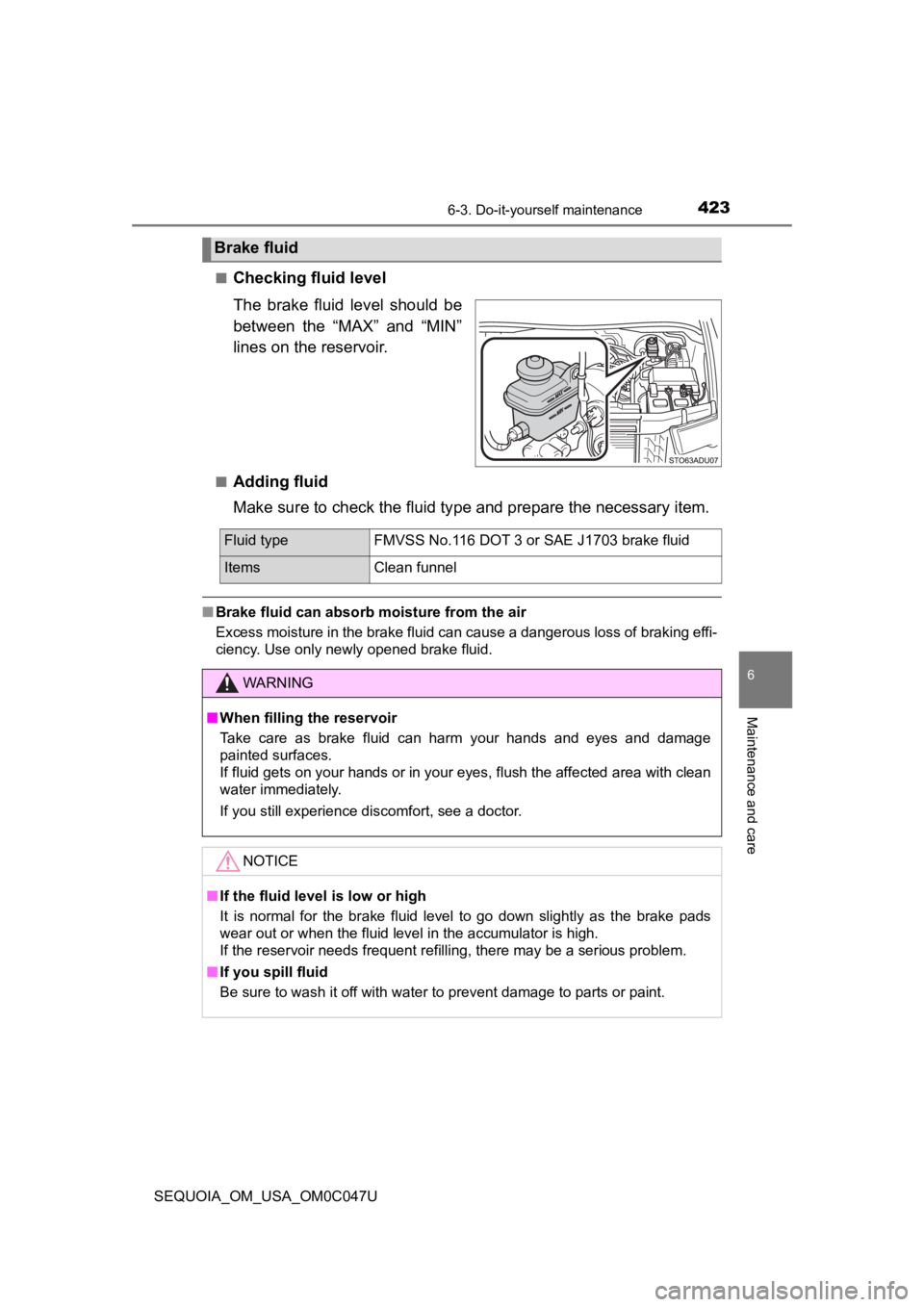
4236-3. Do-it-yourself maintenance
6
Maintenance and care
SEQUOIA_OM_USA_OM0C047U‚ñÝ
Checking fluid level
The brake fluid level should be
between the “MAX” and “MIN”
lines on the reservoir.
‚ñÝAdding fluid
Make sure to check the fluid ty
pe and prepare the necessary ite m.
‚ñÝBrake fluid can absorb moisture from the air
Excess moisture in the brake fluid can cause a dangerous loss o f braking effi-
ciency. Use only newly opened brake fluid.
Brake fluid
Fluid type FMVSS No.116 DOT 3 or SAE J1703 brake fluid
Items Clean funnel
WARNING
‚ñÝWhen filling the reservoir
Take care as brake fluid can harm your hands and eyes and damage
painted surfaces.
If fluid gets on your hands or in your eyes, flush the affected area with clean
water immediately.
If you still experience discomfort, see a doctor.
NOTICE
‚ñÝ If the fluid level is low or high
It is normal for the brake fluid level to go down slightly as the brake pads
wear out or when the fluid level in the accumulator is high.
If the reservoir needs frequent refilling, there may be a serious problem.
‚ñÝ If you spill fluid
Be sure to wash it off with water to prevent damage to parts or paint.
Page 424 of 592
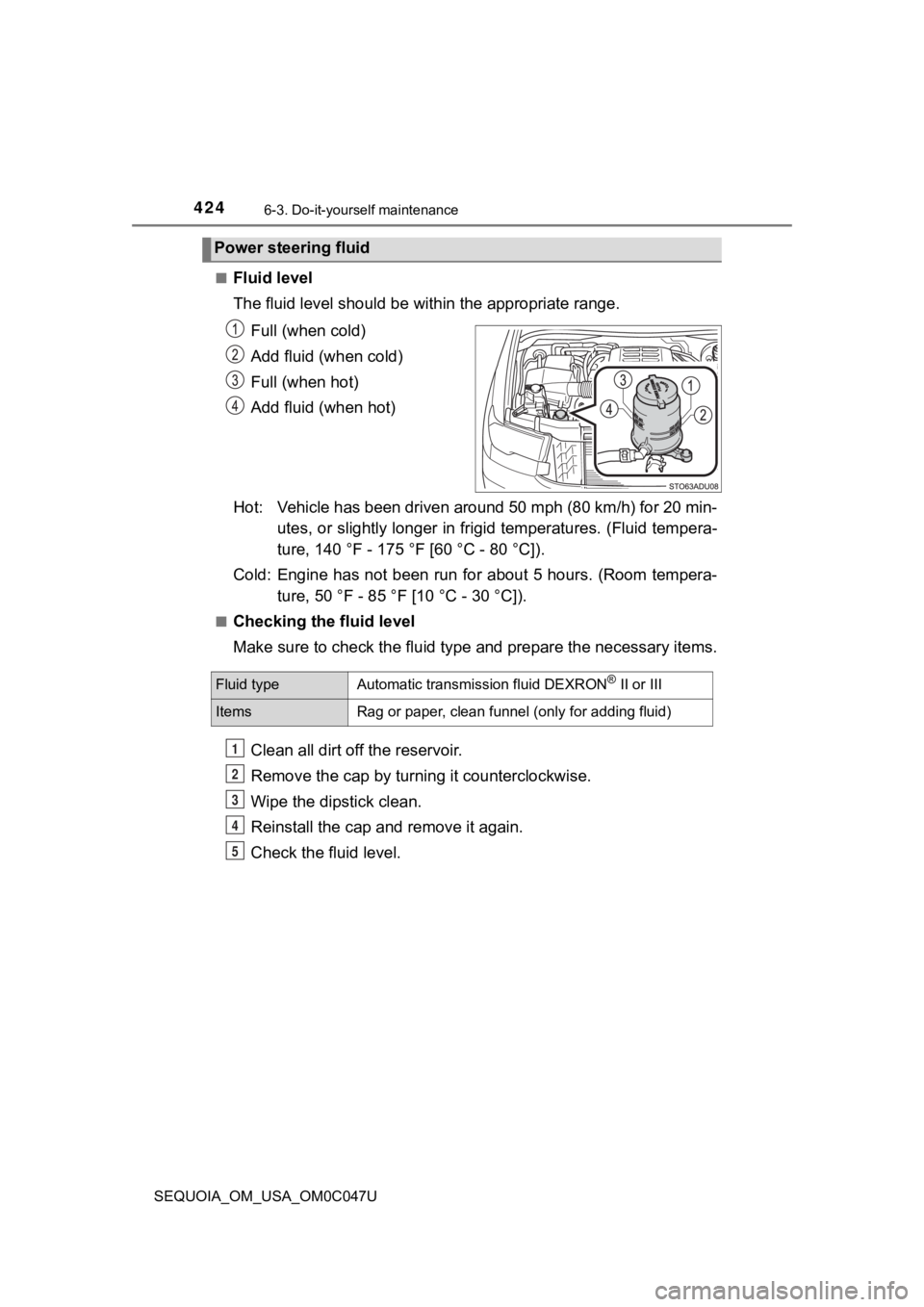
4246-3. Do-it-yourself maintenance
SEQUOIA_OM_USA_OM0C047U‚ñÝ
Fluid level
The fluid level should be within the appropriate range.
Full (when cold)
Add fluid (when cold)
Full (when hot)
Add fluid (when hot)
Hot: Vehicle has been driven around 50 mph (80 km/h) for 20 min- utes, or slightly longer in frigid temperatures. (Fluid tempera-
ture, 140 °F - 175 °F [60 °C - 80 °C]).
Cold: Engine has not been run for about 5 hours. (Room tempera- ture, 50 °F - 85 °F [10 °C - 30 °C]).
‚ñÝChecking the fluid level
Make sure to check the fluid type and prepare the necessary items.
Clean all dirt off the reservoir.
Remove the cap by turni ng it counterclockwise.
Wipe the dipstick clean.
Reinstall the cap and remove it again.
Check the fluid level.
Power steering fluid
Fluid typeAutomatic transmission fluid DEXRON® II or III
ItemsRag or paper, clean funnel (only for adding fluid)
1
2
3
4
5
Page 425 of 592
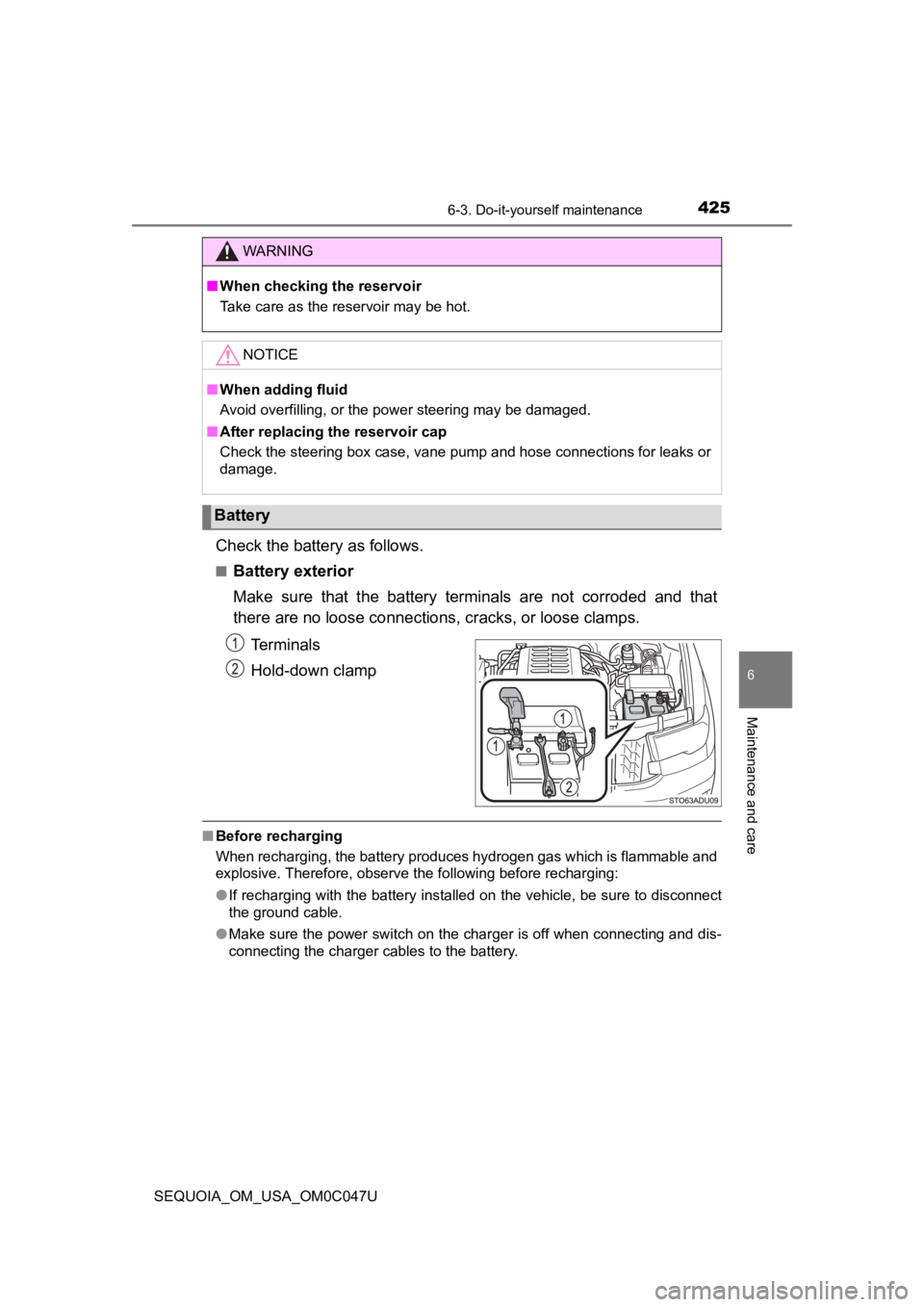
4256-3. Do-it-yourself maintenance
6
Maintenance and care
SEQUOIA_OM_USA_OM0C047U
Check the battery as follows.
‚ñÝBattery exterior
Make sure that the battery terminals are not corroded and that
there are no loose connections, cracks, or loose clamps.Terminals
Hold-down clamp
‚ñÝBefore recharging
When recharging, the battery produces hydrogen gas which is fla mmable and
explosive. Therefore, observe the following before recharging:
‚óè If recharging with the battery installed on the vehicle, be sur e to disconnect
the ground cable.
‚óè Make sure the power switch on the charger is off when connectin g and dis-
connecting the charger cables to the battery.
WARNING
‚ñÝ When checking the reservoir
Take care as the reservoir may be hot.
NOTICE
‚ñÝWhen adding fluid
Avoid overfilling, or the power steering may be damaged.
‚ñÝ After replacing the reservoir cap
Check the steering box case, vane pump and hose connections for leaks or
damage.
Battery
Page 426 of 592
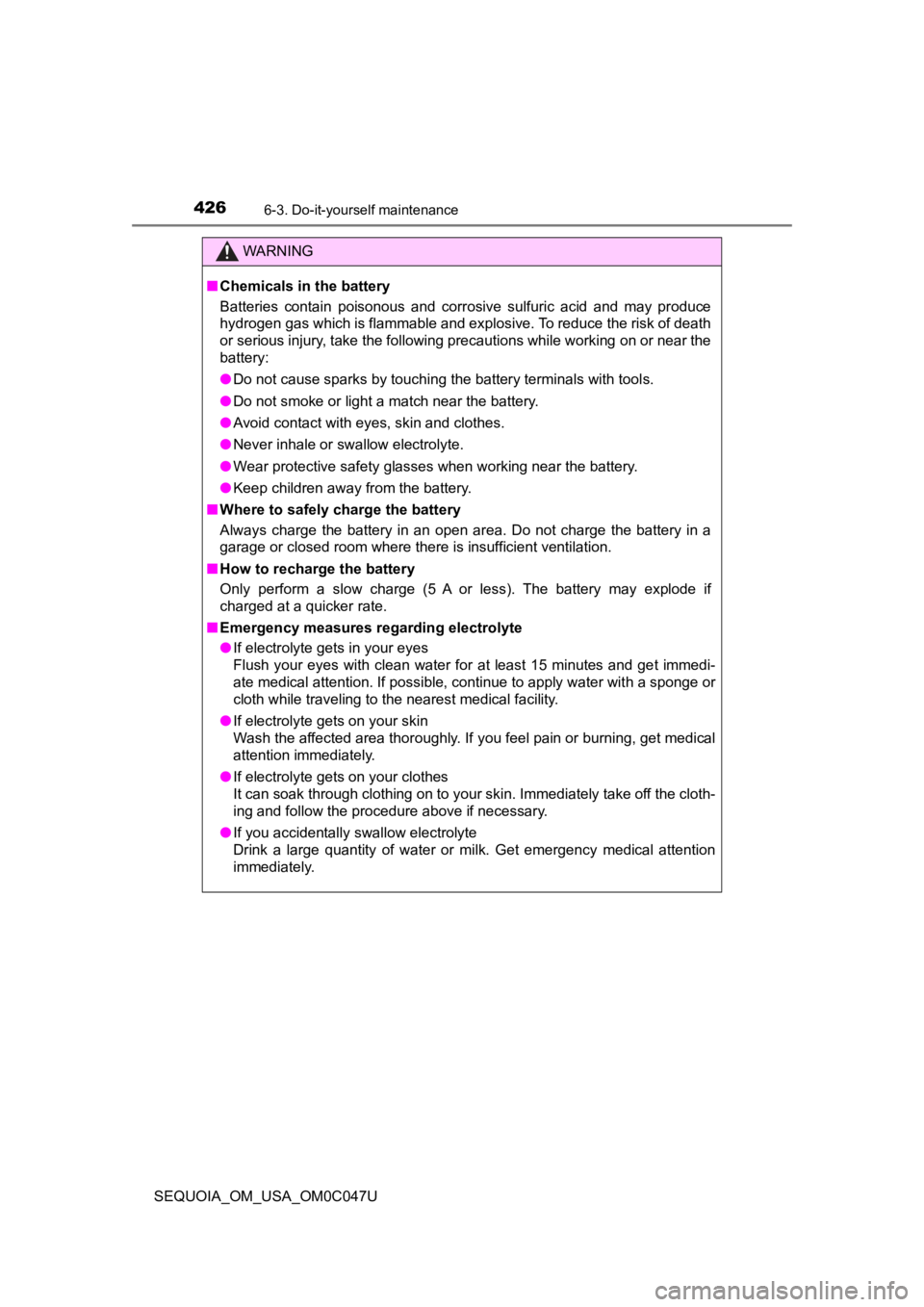
4266-3. Do-it-yourself maintenance
SEQUOIA_OM_USA_OM0C047U
WARNING
‚ñÝChemicals in the battery
Batteries contain poisonous and corrosive sulfuric acid and may produce
hydrogen gas which is flammable and explosive. To reduce the ri sk of death
or serious injury, take the following precautions while working on or near the
battery:
‚óè Do not cause sparks by touching the battery terminals with tools.
‚óè Do not smoke or light a match near the battery.
‚óè Avoid contact with eyes, skin and clothes.
‚óè Never inhale or swallow electrolyte.
‚óè Wear protective safety glasses when working near the battery.
‚óè Keep children away from the battery.
‚ñÝ Where to safely charge the battery
Always charge the battery in an open area. Do not charge the battery in a
garage or closed room where there is insufficient ventilation.
‚ñÝ How to recharge the battery
Only perform a slow charge (5 A or less). The battery may explo de if
charged at a quicker rate.
‚ñÝ Emergency measures regarding electrolyte
‚óè If electrolyte gets in your eyes
Flush your eyes with clean water for at least 15 minutes and ge t immedi-
ate medical attention. If possible, continue to apply water wit h a sponge or
cloth while traveling to the nearest medical facility.
‚óè If electrolyte gets on your skin
Wash the affected area thoroughly. If you feel pain or burning, get medical
attention immediately.
‚óè If electrolyte gets on your clothes
It can soak through clothing on to your skin. Immediately take off the cloth-
ing and follow the procedure above if necessary.
‚óè If you accidentally swallow electrolyte
Drink a large quantity of water or milk. Get emergency medical attention
immediately.
Page 427 of 592

4276-3. Do-it-yourself maintenance
6
Maintenance and care
SEQUOIA_OM_USA_OM0C047U
Add washer fluid in the following
situations:
‚óèA washer does not work.
‚óè The warning message appears
on the multi-information display.
NOTICE
‚ñÝWhen recharging the battery
Never recharge the battery while the engine is running. Also, be sure all
accessories are turned off.
Washer fluid
WARNING
‚ñÝWhen adding washer fluid
Do not add washer fluid when the engine is hot or running as wa sher fluid
contains alcohol and may catch fire if spilled on the engine, etc.
NOTICE
‚ñÝ Do not use any fluid other than washer fluid
Do not use soapy water or engine antifreeze instead of washer fluid.
Doing so may cause streaking on the vehicle’s painted surfaces, as well as
damaging the pump leading to problems of the washer fluid not spraying.
‚ñÝ Diluting washer fluid
Dilute washer fluid with water as necessary.
Refer to the freezing temperatures listed on the label of the washer fluid bot-
tle.
Page 428 of 592
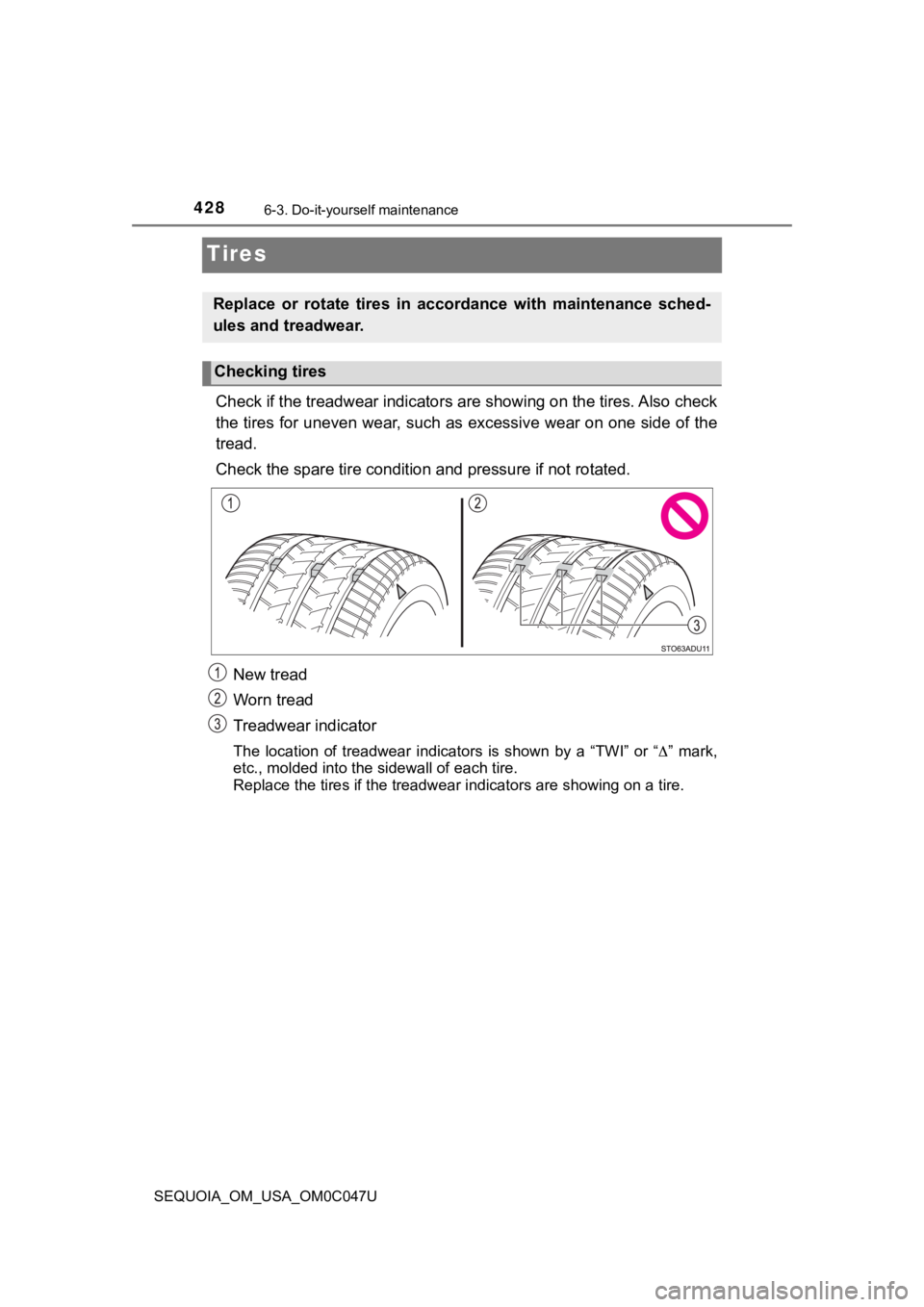
4286-3. Do-it-yourself maintenance
SEQUOIA_OM_USA_OM0C047U
Tires
Check if the treadwear indicators are showing on the tires. Also check
the tires for uneven wear, such as excessive wear on one side o f the
tread.
Check the spare tire condition and pressure if not rotated.
New tread
Worn tread
Treadwear indicator
The location of treadwear indicators is shown by a “TWI” or “ ” mark,
etc., molded into the s idewall of each tire.
Replace the tires if the treadwear indicators are showing on a tire.
Replace or rotate tires in accordance with maintenance sched-
ules and treadwear.
Checking tires
Page 429 of 592
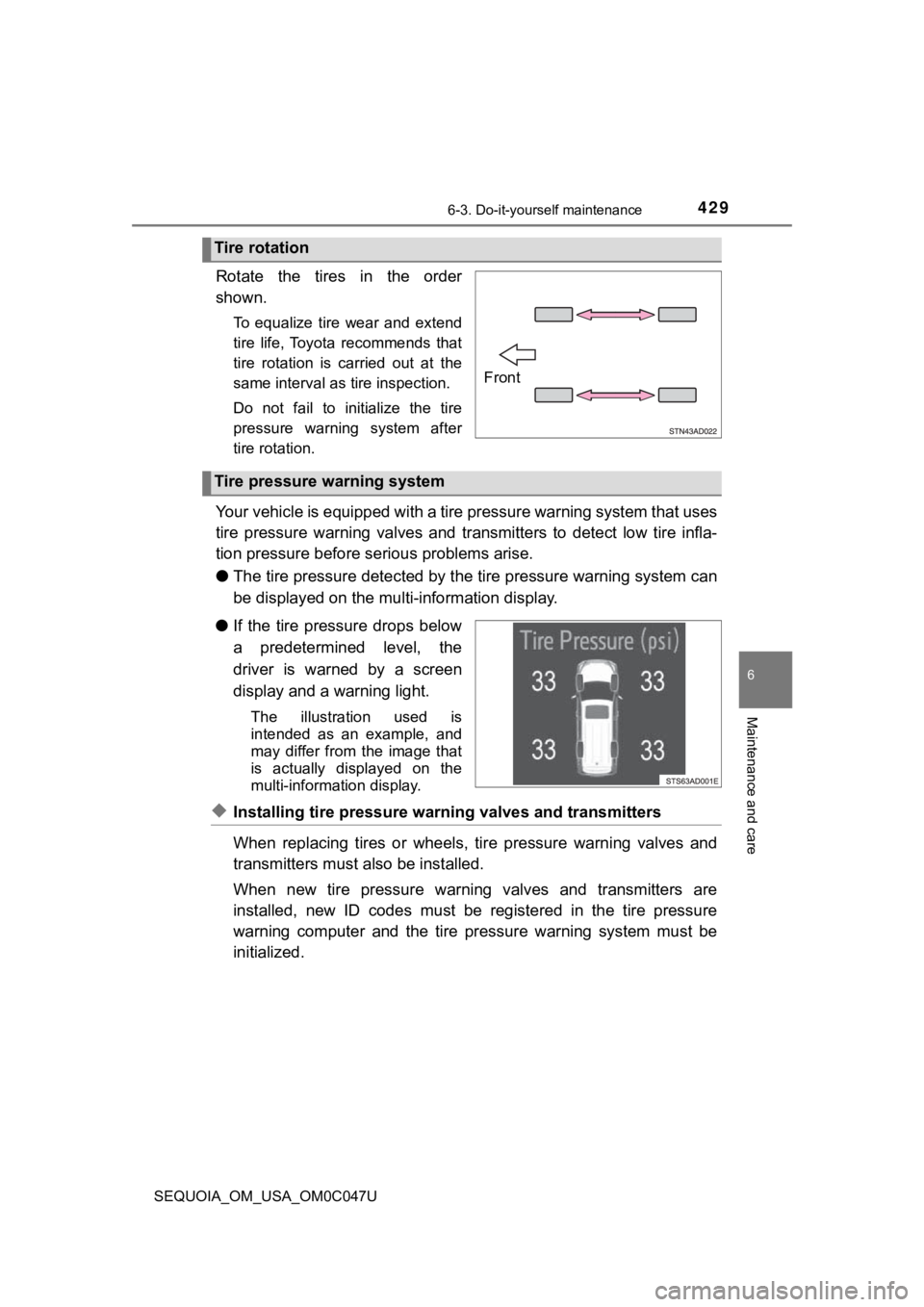
4296-3. Do-it-yourself maintenance
6
Maintenance and care
SEQUOIA_OM_USA_OM0C047U
Rotate the tires in the order
shown.
To equalize tire wear and extend
tire life, Toyota recommends that
tire rotation is carried out at the
same interval as tire inspection.
Do not fail to initialize the tire
pressure warning system after
tire rotation.
Your vehicle is equipped with a tire pressure warning system that uses
tire pressure warning valves and transmitters to detect low tire infla-
tion pressure before serious problems arise.
‚óè The tire pressure detected by th e tire pressure warning system can
be displayed on the mul ti-information display.
‚óè If the tire pressure drops below
a predetermined level, the
driver is warned by a screen
display and a warning light.
The illustration used is
intended as an example, and
may differ from the image that
is actually displayed on the
multi-informat ion display.
‚óÜInstalling tire pressure warn ing valves and transmitters
When replacing tires or wheels, tire pressure warning valves an d
transmitters must also be installed.
When new tire pressure warning valves and transmitters are
installed, new ID codes must be registered in the tire pressure
warning computer and the tire pressure warning system must be
initialized.
Tire rotation
Front
Tire pressure warning system
Page 430 of 592
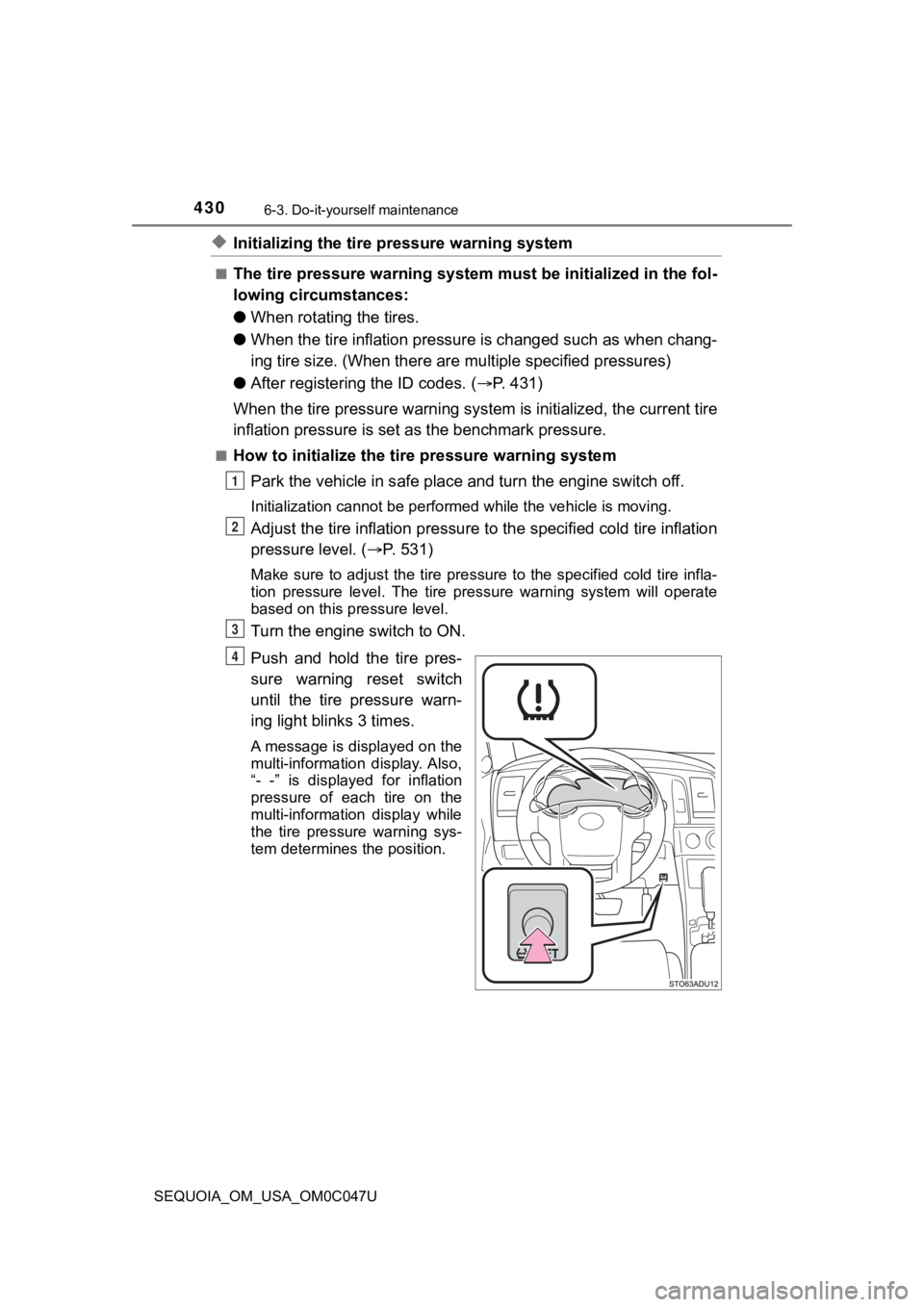
4306-3. Do-it-yourself maintenance
SEQUOIA_OM_USA_OM0C047U
‚óÜInitializing the tire pressure warning system
‚ñÝThe tire pressure warning system must be initialized in the fol-
lowing circumstances:
‚óè When rotating the tires.
‚óè When the tire inflation pressure is changed such as when chang-
ing tire size. (When there are multiple specified pressures)
‚óè After registeri ng the ID codes. ( ÔÇÆP. 431)
When the tire pressure warning sy stem is initialized, the current tire
inflation pressure is set as the benchmark pressure.
‚ñÝHow to initialize the tire pressure warning system
Park the vehicle in s afe place and turn the engine switch off.
Initialization cannot be perfo rmed while the vehicle is moving.
Adjust the tire inflation pressure to the specified cold tire i nflation
pressure level. ( ÔÇÆP. 531)
Make sure to adjust the tire pre ssure to the specified cold tire infla-
tion pressure level. The tire pressure warning system will oper ate
based on this pr essure level.
Turn the engine switch to ON.
Push and hold the tire pres-
sure warning reset switch
until the tire pressure warn-
ing light blinks 3 times.
A message is displayed on the
multi-information display. Also,
“- -” is displayed for inflation
pressure of each tire on the
multi-information display while
the tire pressure warning sys-
tem determines the position.
1
2
3
4